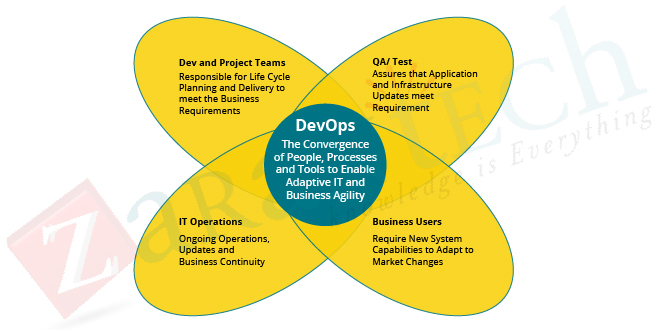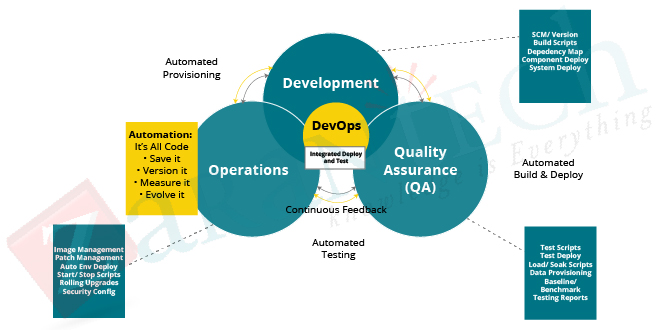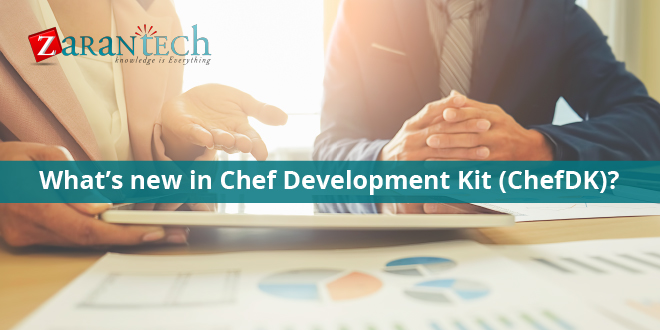DevOps – Is a Methodology or a Set of Products?
Category: DevOps Posted:Apr 18, 2017 By: Serena Josh The term “DevOps” was first coined by Patrick Debois in 2009, who became one of its primary proponents. To put it simply, DevOps is a mix of Software development and Operations. As the name suggests, it’s a fusion of these two disciplines in order to stress cohesion, collaboration and communication between the conventionally distinct development and IT operations teams.
The term “DevOps” was first coined by Patrick Debois in 2009, who became one of its primary proponents. To put it simply, DevOps is a mix of Software development and Operations. As the name suggests, it’s a fusion of these two disciplines in order to stress cohesion, collaboration and communication between the conventionally distinct development and IT operations teams.
Instead of viewing these as two separate groups who are accountable for their individual tasks but don’t really work together, the DevOps methodology identifies the interdependence of the two groups. By unifying these functions as one team or panel, DevOps aids an enterprise deploy software with greater frequency, while retaining service stability and picking up the velocity needed for more innovation.
To compete in the current market, organizations must evolve and adapt to changing customer demands for rapid services, enhanced functionality, cost-efficient solutions, etc. Customer demands generate pressure on organizations to transform into flexible and agile business entities. DevOps integrates the agile development, agile infrastructure and flexible operations on a conceptual level to enable fast and continuous releases and progressive enhancement in IT value creation.

Learn DevOps from Industry Experts
This objective needs a bridge of communication between Software development and Operations, which have historically been dynamic and separate functions, and the application of agile principles to all functions that support the Software Development Life Cycle (SDLC). A successful DevOps implementation is a mix of people, culture, tools, processes and methodologies that minimize business risk and cost enable technology to evolve at the speed of the business, and enhance overall quality.
The Origin of DevOps
DevOps is the resultant product of agile software development – borne from the need to keep up with the increased software speed and throughput agile methods have brought about. Progress in agile culture and techniques over the last decade has brought about the need for a more comprehensive approach to the end-to-end software delivery lifecycle.
Agile Software Development
Agile Development stands for multiple incremental and iterative software development methodologies. The most popular agile methodologies include Scaled Agile Framework (SAFe), Lean Development, Scrum, Extreme Programming and Kanban.
Even though they all share a common vision and core values they are all unique in their specific approaches. All these basically involve iteration and progressive feedback that is provided to successfully refine and deliver a software system. Continuous testing, planning, integration and other types of continuous evolution of the software and the project are involved here. These processes are uncomplicated and “lightweight”, even more so when contrasted with conventional waterfall-style processes which are inherently adaptable. The most noteworthy feature of agile techniques and methods are that they all stress on enabling people to collaborate and take decisions together rapidly and with high effectiveness.
At the start, agile teams were mainly populated by developers. As and when agile teams gain efficiency with regard to production of software, QA and Development teams can no longer be viewed individually as it is comparatively inefficient. Agile approaches have grown to include QA for the purpose of boosting the speed of software delivery. And more so, agile has grown to include the delivery and support teams to span agile processes right from ideation to delivery.
DevOps concepts expand agile development techniques by streamlining the movement of software change via validation, build and deployment and delivery stages. This also enables teams of a cross-functional nature to possess complete ownership of software applications from design right until production support.
DevOps is part of an IT mind-set that promotes integration, collaboration, automation and communication among Software Developers and even IT operations with the focus of enhancing the quality and velocity of delivering software
Automating delivery processes, and standardizing development environments are the main focus of DevOps teams. This focus will result in enhanced efficiency, delivery predictability and even security and maintainability. Production infrastructure comprehension and higher degrees of control over the production environment is made possible due to DevOps Ideals.
DevOps is invaluable from the viewpoint of promoting teams with the autonomy to validate, build and deliver and support indigenous applications.
Challenges Solved by DevOps
Before DevOps application development, teams had to be assigned with collecting business requirements for software programs and writing code.
And to test programs in isolated development environments another QA team will be assigned when requirements are met, who will release code for operations to deploy. And deployment teams are further divided into groups such as database and networking. Such highly fragmented teams cause communication and operational bottlenecks in programming.
Such a system causes several challenges:
- Development is frequently unaware of QA and Operational roadblocks that stop the program from working as planned.
- QA and Operations are usually working across several aspects and have very little context of the business objective and value of the software.
- Every individual group has contradictory objectives that can lead to inefficiency and blaming when processes go wrong.
DevOps caters to these challenges by setting up collaborative cross-functional teams that share responsibility for regulating the system that runs the software and preparing the software to run on that system with increased quality feedback and automation.
Objectives of DevOps
Enhance collaboration between all stakeholders from planning through delivery and automation of the delivery process in order to:
- Enhance deployment frequency
- Accomplish faster time to market
- Decreased failure rates for new releases
- Reducing lead time between fixes
- Enhance mean time to recovery
According to the survey, 2015 State of DevOps Report, high-performing IT organizations deploy 30 times more often with 200 times shorter lead times; they have 60 times fewer system failures and recover 168 times faster.Phases of DevOps Maturity
There are several phases to DevOps maturity; here are a few of the key phases that are needed to be known:
Waterfall Development
Prior to continuous integration, development teams would write code for three to four months. Then those teams would integrate their code to release it. The various versions of code would be so different and have so many differences that the actual integration of code could take months. This process ended up being very unproductive.
Continuous Integration
Continuous integration is the practice of accelerated integration of newly developed code with the main body of code that has to be released. Continuous integration saves a great deal of time when the team is ready to release the code. DevOps didn’t come up with this term. Continuous integration is an agile engineering practice that originated from the extreme programming methodology. The terms have been around for some time, but DevOps has taken on this term as automation is needed to successfully perform continuous integration. This is frequently the first step down the path towards DevOps maturity.
From a DevOps perspective, the continuous integration process involves checking your code in, compiling it into usable and binary executable code and executing some basic validation testing.
Continuous Delivery
Continuous delivery is a part of continuous integration. It is placed atop continuous integration. When performing continuous delivery, one adds additional automation and testing. The reason behind doing this is to not only merge code with the main code line, and facilitate easy deployment. It is good industry practice to have the code base constantly in a ready-to-deploy state.
Continuous Deployment
Continuous deployment is not to be confused with continuous delivery and is the most advanced evolution of continuous delivery. It is the practice of deploying all the way into production sans any human intervention. Newly generated code gets put through automated testing before putting it in production, as against deploying untested code. This will then be put through a beta release wherein a test group of users are given the code and quality is monitored using an automated feedback loop. Companies such as Amazon, Pinterest, Google and Netflix all use continuous deployment.
Values of DevOps
DevOps stresses on setting up a collaborative culture and enhancing efficiency via automation using DevOps tools. While some enterprises and individuals tend to value one over the other, in practice it takes a mix of both culture and tools to be highly successful. Given below is a brief of DevOps values.
DevOps Culture
Minimized silos, autonomous teams, increased collaboration, and highly enhanced quality are the hallmarks of DevOps culture. Several DevOps values are also extensions of the agile methodology. Agile methods are a more comprehensive way of delivering software. Agile development teams assess project progress with working software as a variable. Product owners, testers, developers, and User Interface professionals work closely together with common objectives.
DevOps refers to taking on an operations’ mindset along with at least one team member with some operational responsibilities into the agile team. However previously, DevOps progress was assessed in terms of working software, currently DevOps progress is measured in terms of working software in the consumer’s hands. To accomplish this, Development and Operations must divide the silos and coordinate with each another, distribute responsibility for regulating the system that executes the software, and prepare the software to run on the system with enhanced quality feedback and delivery automation.
DevOps Tools
Test and build systems, version control, configuration management, application deployment and even monitoring tools. Given below are some of the tools:
Source Code Repository
A source code repository is a location where developers check in and modify code. The source code repository manages the different versions of code that are checked in. This is done so that developers don’t over-write other developer’s code.
Source control has probably been around for forty years, but it’s a major component of continuous integration. Popular source code repository tools are Git, Subversion, Cloudforce, Bitbucket and TFS.
Build Server
The build server is an automation tool used for code compilation in the source code repository into executable code base. Common tools are SonarQube, and Jenkins Artifactory.
Configuration Management
This defines the configuration of a server or an environment. Well-known configuration management tools are Chef and Puppet.
Virtual Infrastructure
Microsoft Azure and Amazon Web Services are examples of virtual infrastructures. Virtual infrastructures are offered by cloud vendors that sell Platform as a Service (PaaS) or infrastructure. These infrastructures have APIs that let professionals create programmatically new machines with configuration management tools like Puppet and Chef.
Private clouds also exist. For instance, VMware has vCloud. Private virtual infrastructures allow one to run a cloud atop the hardware in the data center. Enterprises are powered by virtual infrastructures integrated with automation tools practicing DevOps and being able to manage server configuration without manual intervention. Professionals wanting to test new code can automatically transfer it to the cloud for testing; build the environment for testing and then run tests on the code without manual intervention.
Test Automation
Test automation is an established practice which has been around for some time now. DevOps testing stresses automation in testing within the build pipeline so that by the time one has a build which can be deployed, the build can be deployed with the utmost confidence. Tools that can be used are Water and Selenium. Extensive automated testing strategies are essential for successful deployment of software code.
Pipeline Orchestration
A pipeline can be compared to a manufacturing assembly line. This phase begins from the time a developer is completely done with writing all relevant code, and all the way till the deployment happens in production or a final stage pre-production environment.
Unifying Enterprise Software Development and Delivery
Integration of DevOps and agile application lifecycle management is executed through the use of the VersionOne Enterprise Agile Platform. This will offer a complete picture of the whole software delivery pipeline in a single platform.
VersionOne Continuum for DevOps is an enterprise continuous delivery solution for orchestrating, automating, and visualizing the flow of change throughout the entire software delivery cycle.
Conclusion
DevOps is the cutting edge approach to up-quality standards by using existing business resources to streamline coding and testing processes to achieve faster and more efficient deployments. Every organization and Individual professional affiliated with IT and related fields can benefit greatly from adopting DevOps through authorized certifications.
Got any questions for us? Please mention it in the comments section and we will return it to you. At ZaranTech we offer a self-paced online training program for DevOps. Skyrocket your career by learning from the best!
You can also visit our website for more engaging and informative articles.





 99999999 (Toll Free)
99999999 (Toll Free)  +91 9999999
+91 9999999